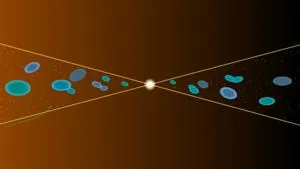
Breakthrough in Quantum Technology: Engineering Entangled Photons at the Nanoscale!
2025-01-14
Author: Arjun
Columbia Engineering's cutting-edge research has made headlines this week with a game-changing invention: a groundbreaking device capable of generating entangled photon pairs. This advances quantum optics and on-chip integration of quantum technology, all while being compact and energy-efficient.
The innovative device is crafted from layered molybdenum disulfide (MoS2) crystals, utilizing a technique known as quasi-phase-matching. This allows researchers to manipulate light properties and successfully generate photon pairs at telecommunications wavelengths with remarkable efficiency and reliability. Comparatively, this new approach outperforms traditional methods that require bulk crystals, marking a significant milestone in nonlinear optics.
As part of a Department of Energy research initiative, this development unlocks enormous potential for scalable quantum systems. The implications are vast, ranging from revolutionizing quantum communication and satellite distribution to enhancing advanced photonic architectures.
The Enigmatic World of Quantum Entanglement
The notion of quantum entanglement has fascinated physicists for nearly a century. Albert Einstein famously termed it “spooky action at a distance,” referring to how two paired photons can instantaneously reflect changes in one another’s state, regardless of distance. Today, entanglement is at the forefront of global research, hailed as the cornerstone of quantum information, primarily through qubits.
Historically, generating photon pairs involved large crystals visible to the naked eye. However, in their groundbreaking paper published in Nature Photonics, the researchers led by Associate Professor P. James Schuck have unveiled a new methodology that achieves unattainable performance metrics with smaller, energy-efficient devices.
“This work represents the embodiment of the long-sought goal of integrating macroscopic and microscopic nonlinear optics with quantum optics,” Schuck states. “It lays the groundwork for on-chip devices that can produce tunable microscopic entangled-photon pairs.”
A Tiny Device with Huge Potential
The newly engineered device measures a mere 3.4 micrometers in thickness, hinting at a future where vital components of quantum systems can seamlessly fit onto a silicon chip. This transformation promises significant advancements in energy efficiency and the technical prowess of quantum devices.
The researchers stacked six 180-degree rotated thin layers of molybdenum disulfide, allowing light to interact in a way that fosters the generation of paired photons. Remarkably, this marks the first instance where quasi-phase-matching has been successfully performed using a van der Waals material to create photon pairs at ideal telecommunications wavelengths.
“The introduction of van der Waals materials signals a new era for nonlinear and quantum photonic architectures and could replace traditional bulk crystals,” Schuck claims. “This breakthrough is poised to have immediate repercussions across various fields, including mobile quantum communication and satellite-based distribution.”
The Journey to Innovation
The team’s discovery stems from previous research conducted in 2022, when the properties of molybdenum disulfide were first adapted for nonlinear optics. Despite initial limitations due to interfering light waves, the introduction of periodic poling successfully overcame this hurdle, allowing efficient photon pair generation at nanoscale measurements.
“Our understanding of this material’s capabilities propelled us to explore periodic poling, leading to the highly efficient generation of photon pairs,” Schuck emphasizes.
Excitingly, this advancement in quantum optics is just the beginning. As researchers continue to navigate the complexities of quantum entanglement and light manipulation at the nanoscale, the potential for groundbreaking applications in a range of fields is limited only by imagination.
Are We on the Cusp of a Quantum Revolution?
Stay tuned as we delve deeper into the transformative world of quantum technologies and their implications on our modern lives!



 Brasil (PT)
Brasil (PT)
 Canada (EN)
Canada (EN)
 Chile (ES)
Chile (ES)
 Česko (CS)
Česko (CS)
 대한민국 (KO)
대한민국 (KO)
 España (ES)
España (ES)
 France (FR)
France (FR)
 Hong Kong (EN)
Hong Kong (EN)
 Italia (IT)
Italia (IT)
 日本 (JA)
日本 (JA)
 Magyarország (HU)
Magyarország (HU)
 Norge (NO)
Norge (NO)
 Polska (PL)
Polska (PL)
 Schweiz (DE)
Schweiz (DE)
 Singapore (EN)
Singapore (EN)
 Sverige (SV)
Sverige (SV)
 Suomi (FI)
Suomi (FI)
 Türkiye (TR)
Türkiye (TR)
 الإمارات العربية المتحدة (AR)
الإمارات العربية المتحدة (AR)